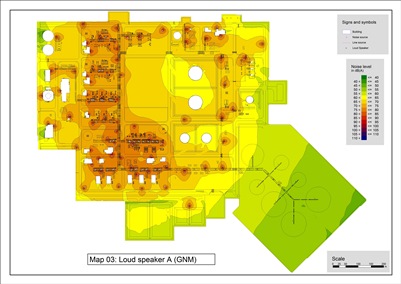
Safe Sounding Workplaces
Using sound mapping software rather than measurements means you can predict future noise levels and take pre-emptive steps to control the noise.
- By Arne Berndt
- Mar 01, 2018
While financial reward is the primary reason for going to work, people have a variety of motivations from personal fulfillment to simply wanting to get out of the house. One thing every worker anywhere in the world should have in common is the right, and expectation, that they can go home in one piece at the end of their working day.
Companies spend millions on personal protective equipment and jump through hoops to meet a variety of stringent health and safety regulations, yet, unfortunately, too many people are still killed or made ill by their occupation.
A significant, but unseen, danger is exposure to excessive noise. This can have an immediate effect or a pernicious, long-term impact on health. Hearing loss is one of the most significant occupational health issues across the world, which should come as little surprise given the range of jobs using noisy equipment or taking place in loud environments.
The National Institute for Occupational Safety and Health, the United States' federal agency responsible for conducting research and making recommendations for the prevention of work-related injury and illness, recommends the noise exposure limit of 85 decibels (dB). That is quieter than a hand drill, so imagine the effect on hearing of exposure to a hammer drill (114dB) or the even louder pneumatic drill (119dB). It's also worth remembering that most people perceive a sound to be twice as loud for each increase of 10dB. A pneumatic drill is therefore more than three times as loud as the recommended exposure level.
This is a noteworthy issue; for example, NIOSH estimates that 84 percent of carpenters, 77 percent of operating engineers, and 73 percent of construction workers are exposed to noise levels over the recommended limit.
Sudden or Gradual Hearing Loss
Hearing loss can be immediate on exposure to a particularly loud or sudden noise. But gradual hearing loss that may go undetected for years is no less devastating. We often take our hearing for granted, but its loss is truly life changing. Even a temporary loss can have significant consequences, especially on our ability to communicate.
As momentous as hearing loss can be, it is not the only health impact to be concerned about. Excessive noise can cause a variety of physical and psychological impairments, including sleep disturbance, cardiovascular disease, and stress. It can also increase the chance of workplace accidents and lead to communications issues.
The risks are not just to workers' health. Businesses' productivity, reputation, and legal standing also can be dramatically impeded if proper mitigation measures aren't put in place to protect people from excessive noise. This is not a matter to be taken lightly, and noise should be part of the risk analysis and planning processes for every business.
Light at the End of the Tunnel
While it may never be possible to eradicate all noise from occupational situations, accurate mapping using noise-mapping software can ensure that everything possible is done to mitigate excessive exposure in a cost-effective manner.
 Noise maps can depict noise levels in a straightforward way using colored contour lines and facade dots according to a user set scale, so that the best option is clear. For example, the placement of barriers or the effect of replacing noisy machinery can be tested on the map before any investment is made.
Noise maps can depict noise levels in a straightforward way using colored contour lines and facade dots according to a user set scale, so that the best option is clear. For example, the placement of barriers or the effect of replacing noisy machinery can be tested on the map before any investment is made.
Noise maps can be produced for a huge range of projects of pretty much any scope and scale. Projects can range from an individual room to industrial complexes that need to determine the 85dB contour line in a plant—so workers know where to use hearing protection—through to country-wide noise maps to record the overall noise situation.
At the levels in between, the software is widely used for a variety of types of projects, for instance, architects determining the type of windows required for a hotel or road designers attempting to minimize the impact of a planned road. Using the latest sound mapping software, realistic simulations can be developed. These show all the sources of noise and how it is dispersed, making it easier to establish key areas for mitigation measures.
With the right noise mapping software, users have a powerful and flexible software tool at their disposal. For instance, some versions allow users to import digital terrain models and overlay Google Maps onto plans. They even allow manipulation of the surroundings, meaning geographical features, even mountains, can be removed or altered to get a better view of the way noise travels from and in any occupational situation.
This sophisticated software is needed because noise measurements only show the overall level of noise, not how much noise came from any individual source. Using computer-devised simulations, problem areas can be isolated and tackled.
Using sound mapping software rather than measurements also means you can predict future noise levels and take pre-emptive steps to control it. When you rely on measurements, you must wait until the noise is being made, and retrofitting noise mitigation solutions is usually far more disruptive and expensive than planned work. The software gives you the option of developing "what-if scenarios" so that the impact of developments or activities can be assessed in advance.
With a noise map, you can accurately identify where mitigation is required and how to defend against problem noise. Even a reduction of a few decibels means many consequences of noise are lessened.
The color coding used in noise maps mean they can be understood easily by anyone, whether they have any understanding of acoustics or engineering or not. They can also be 3D and animated and so can cover any scenario, for instance, noise levels at the tops of buildings or exposure to noise from passing traffic or trains.
Making Efficient Use of Data
All of the data required can be created and stored in a single file for small and medium-sized sound maps, or they can be structured according to planning variant or topic. Larger projects should be structured geographically, which requires a tiling approach to allow the different layers to be examined.
There is strong support in many countries for modeling the noise of buildings, infrastructure, and transport, both at the planning stage and for existing structures. Noise mapping software and the predictions it produces are now accepted as valid and an important part of the process of ensuring citizens are protected from excessive noise.
Technology is the driving force for much of the world's economy, and the way we use the vast wealth of data at our fingertips is constantly evolving. Certainly, in the arena of noise mapping, we have been able to develop significantly as computer processing power has expanded exponentially. Alongside this development, the vast array of data available now means that seemingly impossible tasks can be completed at the touch of a button. Long gone are the days of hand calculations and rough estimates with spreadsheets.
Who would have believed that it would be possible to map and analyze 10 years' worth of flight information from Frankfurt Airport in just a few easy steps? Yet that's what was done as part of the NORAH (Noise Related Annoyance, Cognition, and Health) study, when the radar data for 10 years was uploaded and analyzed in noise mapping software at the touch of a button. The study could then show the direct correlation between the flights and the health of the children in the affected area.
The study looked at the effects of aircraft noise on cognitive performance among 1,090 German second graders from 29 schools in the vicinity of Frankfurt/Main Airport. Along with reading and story recall ability, phonological precursors of reading were assessed to look at the underlying relationship between aircraft noise and reading ability. Analyses revealed significant effects of aircraft noise on children's reading comprehension, even though aircraft noise levels at schools did not exceed 60dB. A 10dB increase in aircraft noise was associated with a worsening result on the reading test, corresponding to a one-month reading delay.
Big Data Can Make a Big Difference
According to IBM: "Big data is changing the way people within organizations work together. It is creating a culture in which business and IT leaders must join forces to realize value from all data. Insights from big data can enable all employees to make better decisions." This is certainly true for noise mapping. The more data there is, and the more accurate it is, then the better the noise map will be and the easier it will be to make important decisions.
Analyzing extensive data on the topic shows the areas most in need of noise mitigation and means that measures can be accurately and cost effectively targeted. Noise mapping allows flexible use of data so that any time period can be mapped and assessed.
Every noise map is unique according to its project size, geography, and objective. The largest single variable, though, is the available data. The best noise mapping software contains a vast library of information on international noise standards, and noise levels from different equipment, vehicles, and surfaces. Only when you know where noise comes from, and at what level, can you take steps to alleviate it using barriers and other acoustic devices. Then you will know you are doing all you can to protect workers from the dangers of excessive noise exposure.
This article originally appeared in the March 2018 issue of Occupational Health & Safety.